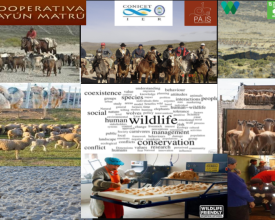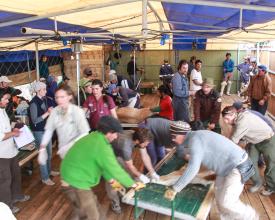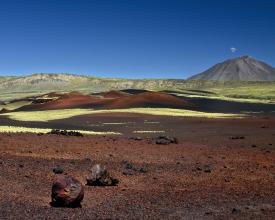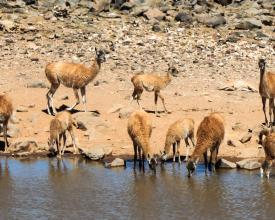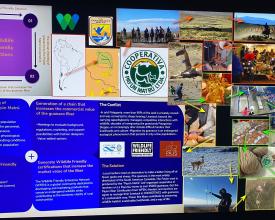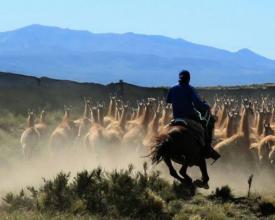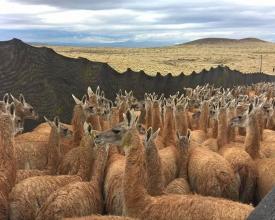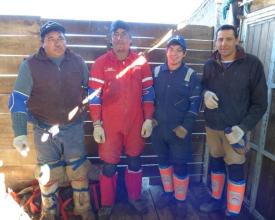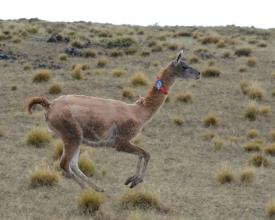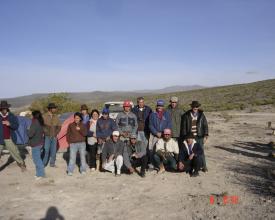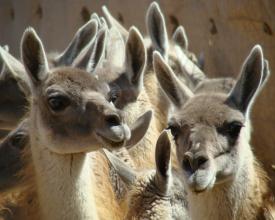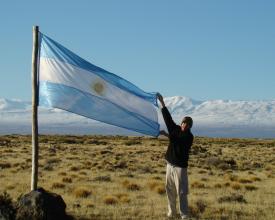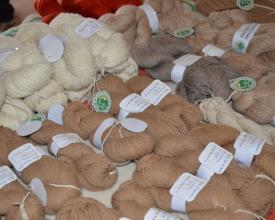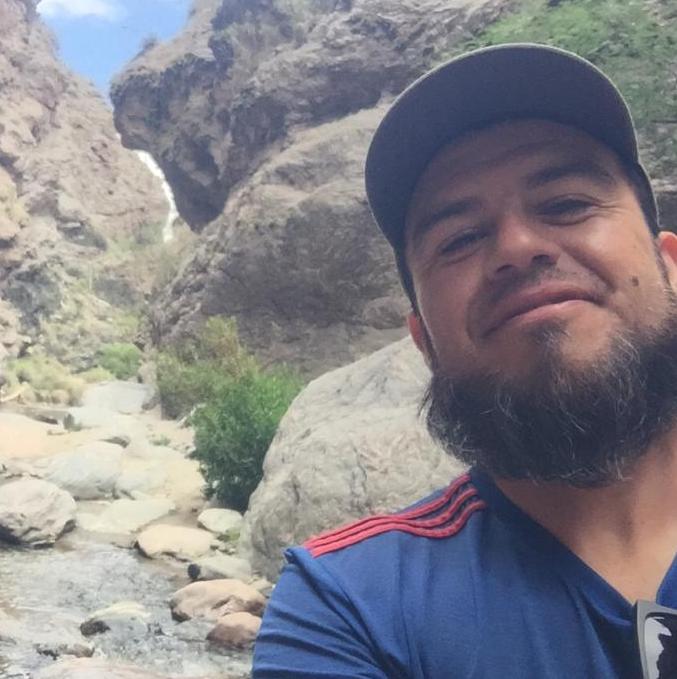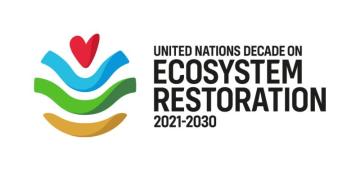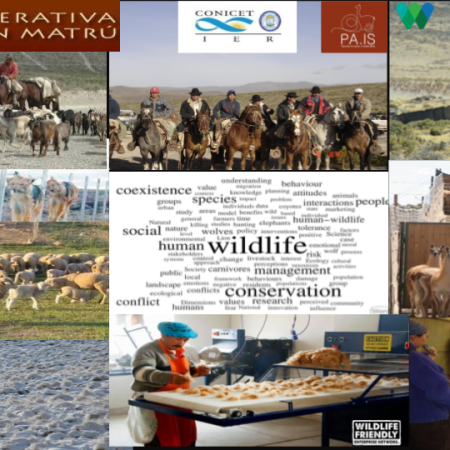
Wildlife Friendly Patagonian Fiber: Creación de capacidad para la sostenibilidad del uso del guanaco.
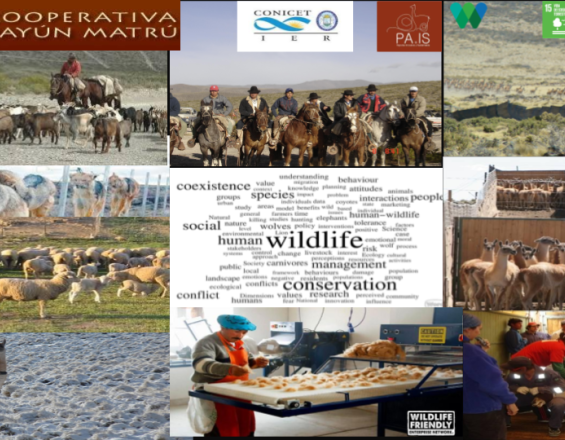
"¿Por qué? Debemos pensar en Acciones "Amigables" con la Vida Silvestre (AMS)"
El propósito de esta solución es resaltar y expandir la importancia del uso sustentable de la fibra del guanaco debido al potencial de esta actividad para generar desarrollo socioeconómico local y convertirse en una efectiva herramienta de conservación reduciendo el impacto de la huella humana. Para lograrlo, nos proponemos 1) Promover el uso sustentable de las poblaciones silvestres de guanacos a través de experiencias demostrativas de esquila en vivo en la Reserva La Payunia; 2) Incentivar la generación de una cadena que incremente el valor comercial de la fibra de guanaco vinculando a los sectores de producción primaria con el sector textil nacional e internacional; 3) Generar certificaciones WFA que incrementen el valor de mercado de la fibra, y 4) Incentivar las acciones de WFA a través de estrategias de comunicación efectivas dando visibilidad al manejo sustentable de los guanacos silvestres. "Creemos en el poder de los consumidores para cambiar los paradigmas del uso de la tierra"
Contexto
Défis à relever
100 años de cría de ovejas en la Patagonia condujeron a la intolerancia humana hacia los guanacos, lo que, combinado con la caza ilegal, ha diezmado las poblaciones silvestres en las áreas protegidas. Nuestro proyecto cumplió los objetivos de 1)conservación de la biodiversidad, al aumentar la abundancia y viabilidad de una de las pocas poblaciones existentes que siguen presentando migraciones anuales a larga distancia, recuperar su papel funcional y cambiar la percepción negativa de la población local por una positiva. 2) Gestión de la tierra, reduciendo el proceso de desertificación de los ecosistemas áridos debido a la mala gestión de la ganadería y a una densidad de ganado superior a la capacidad de carga de los pastizales. 3) Solución social, construyendo un centro textil único en la región (dentro de la Payunia), generando mano de obra local, y evitando la emigración de los jóvenes a los centros urbanos.
Ubicación
Procesar
Resumen del proceso
Los cuatro bloques (B1, B2, B3, B4) deben trabajar en una relación "de abajo arriba", el primer paso (y el más importante) es obtener la materia prima, la lana. Las líneas naranjas son los primeros pasos a completar en B1, las líneas verdes son los pasos a completar en B2, las líneas amarillas son los pasos a completar en B3 (debemos cumplir los requisitos de la WFEN de sostenibilidad social y ecológica, viabilidad poblacional de las especies gestionadas).
Bloques de construcción
Promover el uso sostenible de las poblaciones silvestres de guanaco a través de experiencias demostrativas de esquila en vivo en La Payunia.
La esquila anual de guanacos por parte de la Cooperativa Payún Matrú está siendo supervisada de cerca por el Departamento de Recursos Naturales Renovables de Mendoza para garantizar que los ingresos económicos potenciales que proporciona la lana de guanaco sean viables y sostenibles. Al mismo tiempo, los miembros de la Cooperativa entienden que haciendo "buenas prácticas" reciben "buenos beneficios". El CONICET ha probado y desarrollado métodos para minimizar el estrés de los guanacos individuales durante la captura y el manejo, que reducen los impactos negativos a nivel poblacional. Nuestro conocimiento de los procesos ecológicos, fisiológicos y conductuales que "constriñen" a estos camélidos en La Payunia, basado en más de 10 años de estudio, nos coloca en una posición única para asesorar y enseñar a los actores de la cooperativa y del gobierno cómo minimizar los impactos de la esquila en vivo sobre esta población. Continuaremos capacitando a los miembros de la Cooperativa Payún Matrú en "buenas prácticas" para realizar la captura y esquila de guanacos silvestres dentro de las Acciones Amigables con la Vida Silvestre. En esta etapa se realizarán las siguientes actividades:
Factores facilitadores
1)Encuestas pre-esquila sobre parámetros poblacionales, 2)La capacitación del personal (sin experiencia) a cargo del manejo de los guanacos durante el arreo, dentro de los corrales y durante la esquila es clave para el éxito de las actividades. 3)Manejo de guanacos silvestres: La captura, esquila y liberación de guanacos silvestres se realizará en dos eventos, entre septiembre y noviembre. 4)Indicadores fisiológicos: estrés fisiológico en función de las condiciones de manejo.5)Encuestas post-esquila sobre parámetros poblacionales como estructura social y densidad poblacional.
Lección aprendida
-Como estamos trabajando con fauna silvestre, los relevamientos previos a la esquila sobre parámetros poblacionales nos ayudan a seleccionar la mejor zona para armar la estructura de manejo.
-La capacitación del personal es fundamental (y la clave para el éxito de esta solución) para el buen manejo de los animales, evitando mortalidades de guanacos y lesiones de operarios. El manejo de guanacos silvestres es diferente al de cualquier otro animal doméstico, y es necesario utilizar estructuras y herramientas particulares, así como aprender maniobras específicas para su manipulación, teniendo en cuenta el bienestar animal.
-La aproximación al estrés nos da un indicador fisiológico clave para reducir el estrés en relación al tiempo de manejo.
-Los estudios posteriores al esquileo nos dan parámetros clave de la población como la estructura social y la población nos permiten compararlos con los datos anteriores a la experiencia del esquileo en vivo y definir el impacto en la alteración social.
Incentivar la generación de una cadena que incremente el valor comercial de la fibra de guanaco mediante la vinculación de los sectores de producción primaria con el sector textil nacional e internacional.
Trabajar con diferentes actores a nivel local, nacional e internacional, para contribuir al diseño de una cadena de valor de la fibra que pueda desencadenar la actividad. El trabajo consistirá en la identificación de actores públicos y privados clave, con el fin de brindar herramientas para la comercialización del producto. Las actividades que se desarrollarán en esta etapa del proyecto incluyen reuniones con el sector textil, autoridades de aplicación y diversos actores locales de relevancia en la materia.
Factores facilitadores
-Reuniones con representantes de organismos nacionales para evaluar antecedentes, normativa, comercialización y posibilidades de apoyo a experiencias de manejo de guanacos silvestres.
-Reuniones con diseñadores de moda seleccionados a escala nacional (ej. Buenos Aires) o internacional (ej. Canadá), para generar una cadena de valor justa y promover la experiencia WFA.
-Se identificarán opciones de valor agregado a nivel nacional/internacional a través de reuniones con actores del sector público y privado, para expandir el WFA como una "Solución basada en la naturaleza".
Lección aprendida
Las acciones de gestión de camélidos silvestres comenzaron en los años 80, basadas en la filosofía de los "ICDPs", que buscaban vincular la conservación de la biodiversidad con la mejora de la calidad de vida de la población local. Estos proyectos, que inicialmente se centraron en la vicuña, se basaban en la aplicación de incentivos económicos para promover el aprovechamiento de la fauna silvestre. Demostramos que el uso del guanaco silvestre podría mejorar las cifras de esas iniciativas debido al rango de distribución más amplio de la especie. En Argentina, la producción de fibra de SAC podría duplicarse fácilmente debido a un aumento en el número de poblaciones esquiladas y a un incremento en la frecuencia de esquila. Esto llevaría claramente a un cambio en el paradigma de producción en contraste con el actual. La Cooperativa decidió agregar valor a la fibra cruda con el fin de aumentar el valor. En 2010, la mayoría de los proyectos se habían detenido debido a la dificultad en la comercialización de fibra de guanaco con un precio de USD $ 40-60 por kilo. El "problema" es que sólo hay dos empresas comerciales que compran la fibra cruda que se exporta principalmente a Italia y controlan los precios del mercado.
Generar certificaciones respetuosas con la fauna que aumenten el valor de mercado de la fibra
La provincia de Mendoza cuenta con lo que actualmente consideramos el proyecto de esquila de guanacos más amigable con la vida silvestre que se viene desarrollando desde hace diez años. Por el tipo de manejo que se realiza en La Payunia, existe la posibilidad de que los productos puedan ser certificados Wildlife Friendly. La Wildlife Friendly Enterprise Network (WFEN) es una comunidad mundial dedicada al desarrollo y la comercialización de productos que conservan la vida silvestre en peligro de extinción al tiempo que contribuyen a la vitalidad económica de las comunidades rurales. La Red establece la norma mundial para la venta de productos "verdes" y ayuda a sus miembros a llegar a mercados nuevos y dinámicos. La misión de la WFEN es proteger la vida silvestre mediante la certificación de empresas que garanticen la coexistencia y prosperidad de las personas y la naturaleza. La certificación de la WFEN tratará de promover la conservación de la vida salvaje facilitando prácticas de producción responsables, el desarrollo empresarial, la educación y la creación de marcas. También tratará de acceder a mercados nuevos y dinámicos y conseguir un precio justo para los productos respetuosos con la vida silvestre.
Factores facilitadores
En primer lugar, el solicitante debe presentar el Formulario de Evaluación Previa de Productos Globales de la WF y el Formulario de Referencia, para solicitar la Certificación. El Formulario de Pre-evaluación proporciona información sobre los productores, sus productos y las condiciones de conservación de la vida silvestre en su área para entender si los productos pueden cumplir con los Criterios de la Misión WFEN. El Formulario de Referencia debe ser completado por alguien de una organización conservacionista que esté familiarizado con el programa y su contexto de conservación. La preevaluación y el formulario de referencia deben ir acompañados de una tasa no reembolsable de 250 dólares.
Lección aprendida
Basadas en los principios de conservación de la vida salvaje, bienestar económico y responsabilidad, cada una de nuestras líneas de productos certificados ilustra las posibilidades de éxito de la triple cuenta de resultados para las personas, el planeta y los beneficios.
Para obtener la certificación de la Red es esencial que exista un vínculo directo entre producción y conservación. Los productos que donan un porcentaje de los beneficios a la conservación pero no reducen las amenazas a especies clave quedan fuera de la WFEN. Para ayudar a garantizar que las comunidades que conviven con la vida salvaje adoptan prácticas de conservación, los beneficios asociados deben ser tangibles y significativos. Los productos certificados deben contribuir al aumento de los ingresos locales y/o a la mejora de los medios de subsistencia. La misión de conservación del producto incluye un mecanismo de aplicación claro, de forma que el incumplimiento de las acciones de conservación requeridas tenga consecuencias inmediatas, incluida la pérdida de cualquier recompensa económica. La incapacidad para realizar correcciones sustanciales en un plazo razonable dará lugar a la suspensión de la Red, incluida la pérdida de la certificación y del suministro de información a vendedores y distribuidores.
Fomentar que las Acciones Amigables con la Vida Silvestre (es decir, el uso del guanaco) puedan aportar soluciones al conflicto generado entre el paradigma de la conservación y el de la producción ganadera.
La comunicación es vital para cualquier empresa, negocio o actividad profesional. De nada sirve tener muchos conocimientos y grandes habilidades para generar un buen producto si no conseguimos hacernos visibles de una manera eficaz, atrayendo a los consumidores. Para las grandes empresas (debido a que disponen de presupuesto y específicamente asignado), es relativamente fácil encontrar la visión perfecta y conseguir dar forma a la campaña. Estrategias SEO, SEM, cuestiones de usabilidad y UX, social media, implementación de canales como email marketing o SMS, etc. Una buena campaña sabe hacerse un hueco en todas estas áreas. Sin embargo, es un error pensar que sólo las empresas con grandes recursos pueden tener una buena presencia digital o fuera de ella. Cuando hablamos de "comunicación social" debemos tener en cuenta que no todo el mundo tiene acceso a cada una de las plataformas digitales disponibles, ni está presente en todas las redes sociales existentes. Consideramos una estrategia "exitosa" si conseguimos ganar visibilidad utilizando los canales de comunicación más frecuentes disponibles para captar interés y fidelizar.
Factores facilitadores
"crear, medir y aprender" posibles estrategias de comunicación (com) sobre el AMF. En estos talleres se explicarán las directrices básicas sobre estilos de com, repercusiones de las distintas estrategias y escala de las mismas. Algunas campañas querrán ganar visibilidad, notoriedad, generar compromiso en las redes sociales o simplemente causar un impacto considerable para que el público actúe. Formación para acciones de comunicación con el fin de crear y reforzar la capacidad de las partes interesadas nacionales y las comunidades locales para ampliar la AMF.
Lección aprendida
Los miembros de la Cooperativa PayúnMatrú podrán en el futuro enseñar los métodos aprendidos durante este proyecto a otros grupos que deseen manejar guanacos en la Patagonia. Las acciones amigables con la vida silvestre para obtener fibra de guanaco se convierten en un procedimiento estándar por parte de los productores de fibra de guanaco de toda la Estepa Patagónica.
Los esfuerzos de comunicación aplicados hasta el momento, a través de pequeñas notas en páginas de ciencia, canales de televisión y radio para difundir nuestro proyecto dieron sus frutos. Ya que una de ellas llegó a los directivos de Good Growth, la empresa internacional que conecta ciencia, clientes con las Marcas más exitosas del mundo.Con la ayuda de WCS que es representante de la WFEN y como tal, actúa de nexo entre ambas empresas para firmar un contrato, en el que se establecen dos puntos importantes: a)las partes entienden que los costos de una operación de manejo bien realizada implican que el precio base de la fibra cruda de guanaco debe ser de 200$; b)la compra de 100 kilos a la Cooperativa Payun Matru.
Impactos
"Conservación de la biodiversidad y problema de la gestión de tierras"
Uno de los retos más enojosos y polarizantes de Sudamérica es cuál es la "mejor manera" de gestionar las tierras públicas establecidas para usos múltiples, como la extracción de recursos naturales, la vida salvaje y el ocio. En la árida Patagonia, más del 95% de la tierra es de propiedad privada y, en su mayor parte, se dedicó a la cría de ovejas, lo que provocó una grave desertización de los hábitats y el declive de especies salvajes como el guanaco. Como la ganadería se ha vuelto menos rentable en las últimas décadas, muchas personas buscan alternativas económicas.
"La solución del WFA repercute en la conservación de la biodiversidad y la gestión de la tierra"
Una comunidad auto-organizada en una cooperativa ("Payun Matru") de personas que viven alrededor de la reserva La Payunia ha estado llevando a cabo la esquila en vivo de guanacos para recolectar su valiosa lana. Consideramos que el aprovechamiento de los camélidos silvestres (nuestra fauna silvestre) tendría un rol fundamental en la reducción del proceso de desertificación de los ecosistemas áridos (solución de área protegida paisajísticamente), brindando una alternativa económica (sumada al alto valor comercial de la fibra de guanaco en el mercado externo) para los productores locales (solución social) y aumentando la rentabilidad de la tierra. Cambiamos el Conflicto con COEXISTENCIA
Beneficiarios
Una comunidad (más de 60 familias) auto-organizada en una cooperativa "Payun Matru". Este premio ayudará a crear formadores de WFA con los miembros de la Coop., para consolidar la experiencia en la región y ampliar WFA a otras provincias (por ejemplo, Chubut, Santa Cruz).
Objetivos de Desarrollo Sostenible
Historia

"El conflicto
Uno de los retos más enojosos y polarizantes de Sudamérica es cuál es la "mejor manera" de gestionar las tierras públicas establecidas para usos múltiples, como la extracción de recursos naturales, la vida salvaje y el ocio. En la árida Patagonia, más del 95% de la tierra es de propiedad privada y, en su mayor parte, se convirtió a la cría de ovejas, lo que llevó a la intolerancia del guanaco en estas áreas, combinada con la caza ilegal, ha diezmado las poblaciones. La migración de los guanacos es un fenómeno ecológico en peligro de extinción que sólo persiste en unas pocas poblaciones (por ejemplo, en Payunia).
En la Patagonia rural todavía hay pastores trashumantes, que recorren con sus rebaños rutas tradicionales de hasta 200 km entre las zonas de alimentación invernales y estivales, acompañados por sus familias y a veces incluso por el profesor del colegio de los niños. La densidad del ganado es superior a la capacidad de carga de la pradera y los rebaños están mal gestionados, lo que aumenta las interacciones competitivas con la fauna salvaje (por ejemplo, los guanacos) y hace que el ganado sea más susceptible a enfermedades que pueden transmitirse a la fauna autóctona. Esto se traduce en un mal estado del ganado, décadas de sobrepastoreo (de los pastizales de la estepa patagónica) y un clima cada vez más seco han hecho más difícil la supervivencia de los pastores y la solvencia de los ganaderos, amenazando sus medios de vida y su cultura.
"La solución
Los pastores locales necesitan una alternativa para ganarse mejor la vida con menos cabras y ovejas. A su vez, esto ayudará a la recuperación del hábitat y reducirá la competencia y los conflictos con la fauna salvaje. El guanaco es el camélido sudamericano más extendido, desde la Patagonia hasta Perú, pasando por el oeste de Argentina. La lana de Payún es producida por la cooperativa autoorganizada de ganaderos "Payún Matrú", muchos de los cuales pertenecen a familias que llevan entre 50 y 100 años produciendo lana de cabra en La Payunia, un área protegida de 6.641 km2 en el norte de la Patagonia. El distintivo de la Payunia se basa en su aspecto volcánico, sus paisajes, sus relieves, lógicamente en relación con la fauna (hogar de más de 25000 guanacos), la flora única (distrito fitogeográfico "La Payunia"), y los aspectos culturales de la zona. Nos centramos en esta solución deseable, con el fin de obtener la Certificación de fibra Payun de la asociación Wildlife Friendly®. Los pastores y ganaderos se comprometen a manejar su ganado en coexistencia con los guanacos de manera sustentable. Estas finas fibras contribuyen a preservar el hábitat de la vida silvestre, medios de vida sostenibles y una forma de vida.

